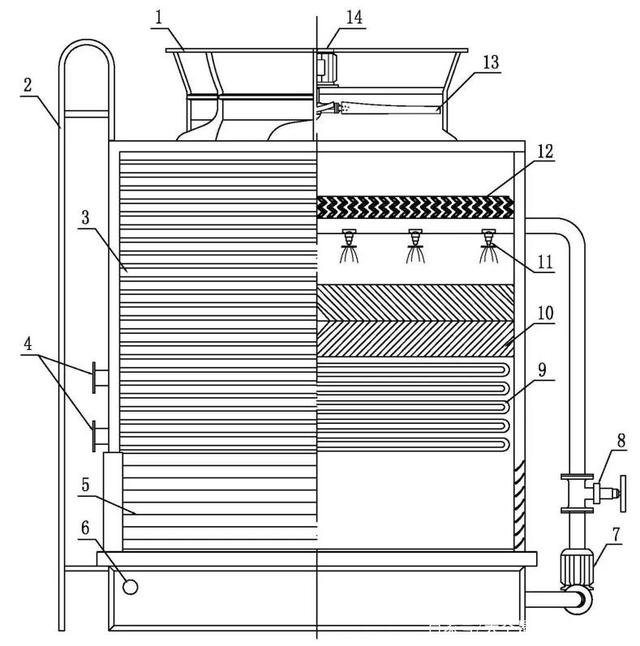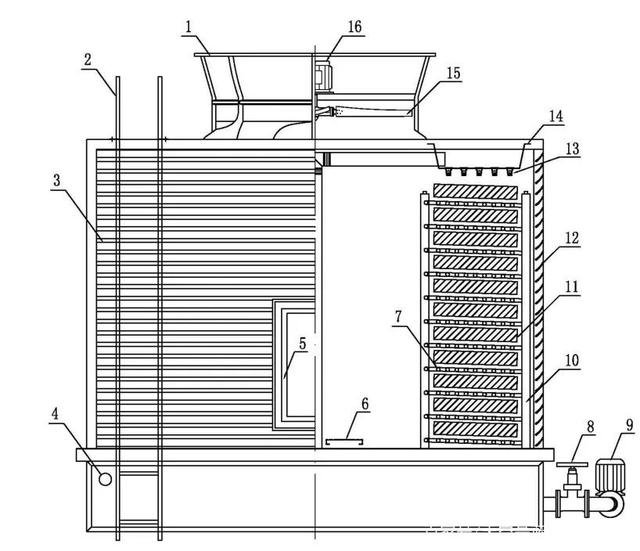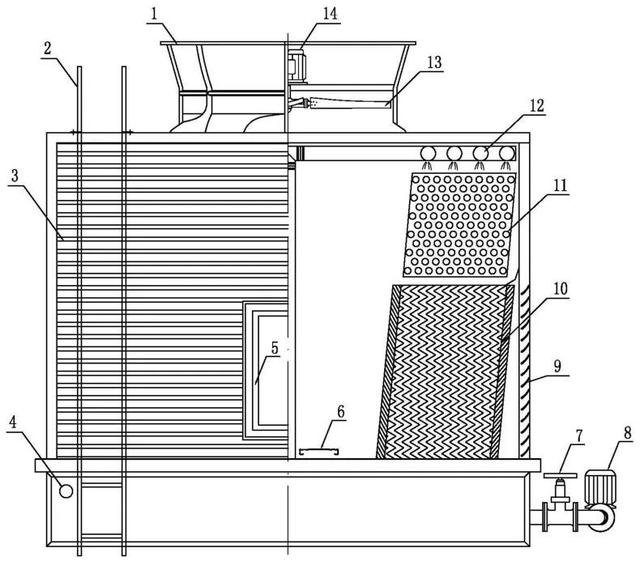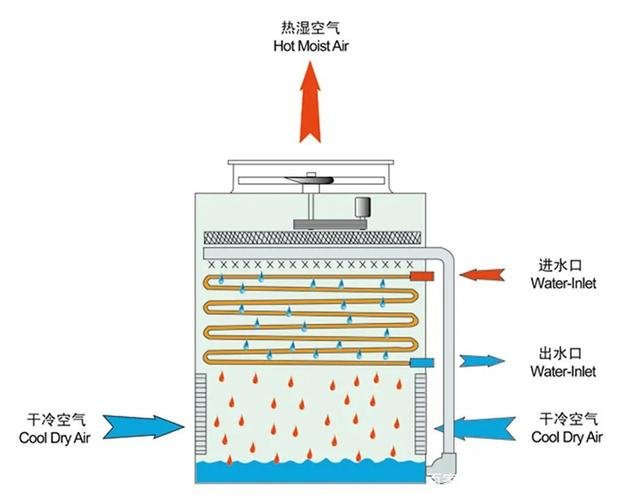First, what is a closed cooling tower?
Namely closed evaporative cooling tower, also known as closed cooling tower or closed tower. It is a cooling tower that transfers heat from circulating water to air through coils.
Its main structure is shown in the figure:






The closed tower is generally composed of fan, radiator (coil), self-circulating water pump, water distribution system, water receiver, tower structure, packing (with or without), gate valve and other components.
Different from the open tower, the hot water of the closed tower is closed cycle and does not directly contact with the air, which can ensure the cleanliness of the circulating water quality, ensure the efficient operation of the main equipment and improve the service life of the main equipment. When the temperature outside is low, the closed tower can be turned into air cooling operation by closing the self-circulating spray system, so as to save water resources. In line with China's policy of energy conservation, emission reduction and water saving, it has been widely used in steel, metallurgy, electric power, electronics, mechanical processing, food, chemical industry and air conditioning system in the past ten years.
The heat dissipation mechanism of the closed tower is as follows: the heat of hot water is first transmitted to the radiator, and then the radiator is transmitted to the shower water on its surface. The shower water and air exchange heat to the air through heat transfer by contact and mass transfer by evaporation. The principle diagram of its cooling process is as follows:

Schematic diagram of heat dissipation mechanism of closed tower
The following is a brief description of the thermodynamic calculation process of the closed tower.
Before proceeding to the derivation of the equation, let us assume the following:
(1) Spray water film in the whole heat exchanger for the average water film temperature, and remain unchanged (this is because the water temperature of the self-circulating water into the radiator and out of the radiator is the same);
(2) The surface area of the water film is approximately equal to the surface area of the coil, that is, the water film is considered very thin;
(3) Self-circulating water is evenly distributed on different tube rows, and there is a water film on the surface of each coil;
(4) If the Lewis number is equal to 1, evaporation loss is not taken into account.
(Note: The following derivation process is mainly based on enthalpy difference drive, energy conservation and other mechanisms and some heat transfer knowledge.)
First, hot water transfers heat to the water film outside the coil, and the heat transfer equation is:

Where, dQ- heat transfer of micro unit, W;
K1- heat transfer coefficient of hot water to water film; W/(㎡·℃);
T- Temperature of process fluid or hot water, ℃;
t- Temperature of self-circulating water film, ℃;
dA- Coil micro unit surface area, ㎡
Coil tube can be regarded as thin-walled tube, and its heat transfer coefficient can be expressed as:

Where, heat transfer coefficient of fluid in AI-coil tube, W/(㎡·℃); λg-tube fluid heat transfer coefficient, W/(㎡·℃); λ-tube fluid heat transfer coefficient, W/(㎡·℃); σ-Thickness of coil, m; α Convective heat transfer coefficient of w- water film, W/(㎡·℃) Di, Do, Dn, Dc- are respectively the inner and outer diameter of coil and the inner and outer diameter of coil after scaling, m.
What is less certain in the above equation is the convective heat transfer coefficient of the water film, and its value is related to the state and thickness of the water film, as well as the self-circulating water quantity, wind speed, coil diameter and layout size. That is:

Where,
q- self-circulating water density, kg/(㎡·s);
v- Average air velocity through coil section, m/s;
p1,pt-coil arrangement, m.
According to assumption (2), heat transfer between water film and air can be written:

Where, β'x- the mass coefficient driven by the enthalpy and humidity difference based on the water film area, kg/(㎡·s);
Bx- based on the surface area of the coil of enthalpy and humidity difference as the driving force of the dispersion coefficient, referred to as the dispersion coefficient, kg/(㎡·s);
i"t- enthalpy of saturated air corresponding to water temperature t, J/kg;
i- enthalpy of air, J/kg(DA);
dA- Coil micro unit surface area,㎡.
The dispersion coefficient in the above equation is an unknown parameter, which needs to be obtained through tests. The value of this parameter is related to the water flow rate, air velocity and coil arrangement, and can be expressedas:

The increase in enthalpy of air is equal to the heat transfer ratio of air in the microcell:

Where, G- mass flow of dry air, kg/ (㎡·s).
After sorting out Formula (6) :

it is noted that IT is the enthalpy of saturated air corresponding to the water temperature of the film. The water temperature is assumed to be constant according to (1), so the enthalpy is also constant. The integral solution of Equation (7) can be obtained:

Where,
i1- enthalpy of air entering the closed tower, J/kg (DA);
i2- Enthalpy of air discharged from closed tower, J/kg (DA).
Mw is the area cooling number of the water film, and its value is:

In addition, the change of self-circulating water temperature is equal to the energy change of air and process fluid, namely:

Where,
qp- Water flow in coil, kg/s;
qw- self-circulating water quantity, kg/s;
cpp, cpw- Specific heat of water in coil and self-circulating water, J/ (kg·℃).
According to hypothesis (1), equation (10) is zero and can be ignored.
On the other hand, Formula (1) can be obtained:

It is also noted that the water temperature of the film is assumed to be constant. By integrating equation (11), we can obtain:

Where,
T1 - temperature of process medium or hot water entering the closed tower, ℃
T2- Process medium or hot water temperature of discharged closed tower, ℃
Where, NTU is referred to as the number of heat transfer units of evaporative cooling tower, and its value is:

According to the assumed condition (4), ignoring the evaporation loss of self-circulating water, the heat transfer of the closed cooling tower is:

By substituting equations (8) and (12) into equation (14), we can get:

Further solution is obtained:

According to Equation (15), the self-circulating water temperature can be calculated by iterative method.
In the derivation process, the above formula does not specifically target the countercurrent type, so the above formula is also applicable to the cross-flow closed tower. The self-circulating water temperature of the closed cooling tower with packing is low, so the heat transfer effect of packing can be equated to the dispersion coefficient, and then thermodynamic calculation can be carried out according to the above formula.
When the heat transfer coefficient and mass dissipation coefficient of the closed cooling tower are known, the self-circulating water temperature can be calculated by Formula (16). With the self-circulating water temperature, the temperature of process fluid after cooling and the enthalpy of air discharged from the closed cooling tower can be calculated by formula (8) and Formula (12).
The above equation can also be used to sort out the test data of the closed cooling tower. In the test, parameters such as inlet and outlet temperature of process fluid, dry and wet bulb temperature of air inlet tower, air flow rate and self-circulating water amount can be measured. From these parameters, the number of heat transfer units can be calculated from Equation (12), and the number of cooling area of effluent film can be calculated from equation (8). The heat transfer coefficient and dispersion coefficient of the closed tower can be obtained by further calculation.
The above is the simple thermodynamic calculation method of closed cooling tower. Is it full of dry goods
Post time: Jun-12-2023

